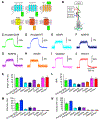Comparative Evaluation of Genetically Encoded Voltage Indicators
- PMID: 30650368
- PMCID: PMC7075032
- DOI: 10.1016/j.celrep.2018.12.088
Comparative Evaluation of Genetically Encoded Voltage Indicators
Abstract
Imaging voltage using fluorescent-based sensors could be an ideal technique to probe neural circuits with high spatiotemporal resolution. However, due to insufficient signal-to-noise ratio (SNR), imaging membrane potential in mammalian preparations is still challenging. In recent years, many genetically encoded voltage indicators (GEVIs) have been developed. To compare them and guide decisions on which GEVI to use, we have characterized side by side the performance of eight GEVIs that represent different families of molecular constructs. We tested GEVIs in vitro with 1-photon imaging and in vivo with 1-photon wide-field imaging and 2-photon imaging. We find that QuasAr2 exhibited the best performance in vitro, whereas only ArcLight-MT could be used to reliably detect electrical activity in vivo with 2-photon excitation. No single GEVI was ideal for every experiment. These results provide a guide for choosing optimal GEVIs for specific applications.
Keywords: 1-photon microscopy; 2-photon microscopy; genetically encoded voltage indicators; in vitro; in vivo; optical field potential; single cell; wide-field imaging.
Copyright © 2018 The Author(s). Published by Elsevier Inc. All rights reserved.
Conflict of interest statement
DECLARATION OF INTERESTS
The authors declare no competing interests.
Figures







References
-
- Ahrens MB, Orger MB, Robson DN, Li JM, and Keller PJ (2013). Whole-brain functional imaging at cellular resolution using light-sheet microscopy. Nat. Methods 10, 413–20. - PubMed
-
- Akemann W, Mutoh H, Perron A, Rossier J, and Knöpfel T (2010). Imaging brain electric signals with genetically targeted voltage-sensitive fluorescent proteins. Nat. Methods 7, 643–649. - PubMed
-
- Bando Y, Irie K, Shimomura T, Umeshima H, Kushida Y, Kengaku M, Fujiyoshi Y, Hirano T, and Tagawa Y (2016). Control of Spontaneous Ca2+ Transients Is Critical for Neuronal Maturation in the Developing Neocortex. Cereb. Cortex 26, 106–117. - PubMed
Publication types
MeSH terms
Grants and funding
LinkOut - more resources
Full Text Sources
Other Literature Sources

